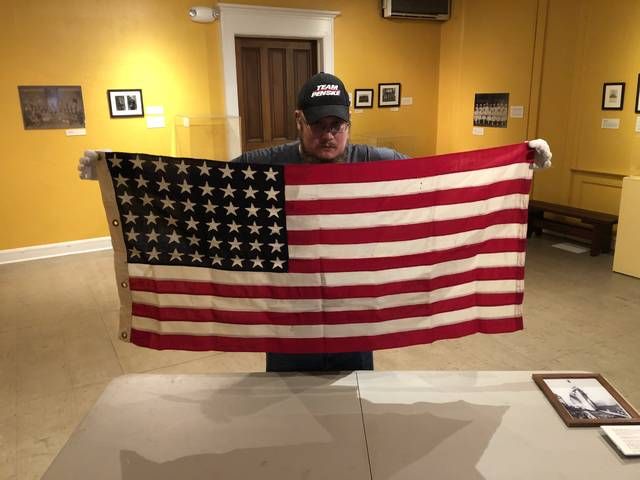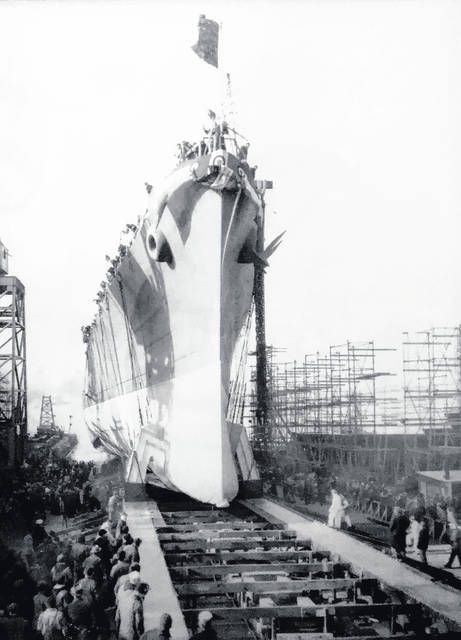
Luzerne County Historical Society Director of Operations and Programs Mark Riccetti Jr. holds up a 1940s-vintage 48-star U.S. flag from the USS Wilkes-Barre which is among several items from the ship recently donated to the society.
Roger DuPuis | Times Leader
Luzerne County Historical Society adds 48-star flag, manual, to collection of items from ship
Click here to subscribe today or Login.
WILKES-BARRE — Its broken hull lies in two pieces beneath the waves off Key West, but several artifacts from the USS Wilkes-Barre recently came “home” to the warship’s namesake city in Northeastern Pennsylvania.
The Luzerne County Historical Society on Friday received two flags from the ship — a 48-star U.S. flag and a signal flag used in maritime communications — courtesy of a Navy veteran in South Carolina.
His hands covered in white library gloves, society Director of Operations and Programs Mark Riccetti Jr. carefully lifted the Stars and Stripes from a display table on Friday, gingerly holding the nearly 80-year-old flag aloft for a photograph.
“Just the fact that we have one of the flags that flew over the ship while it was in service, while it was commissioned, is fantastic,” Riccetti said in a reverent near-hush. “It’s a fantastic piece of history.”
The flags will join other items from the USS Wilkes-Barre in a special display Riccetti and his team are assembling: They will include an operations manual donated last month by Laurea Kimsel of Dallas, as well as the ship captain’s silver and other items already in the society’s collection.
That collection also includes a captured Japanese machine gun that was presented to the citizens of Wilkes-Barre by the ship’s officers and crew back in 1946. Long displayed on an upstairs landing in the society’s South Franklin Street museum, the gun “probably won’t fit in the display case,” Riccetti chuckled.
“It’s a favorite piece with the public, especially with school groups,” he said.
A storied history
The USS Wilkes-Barre’s service history was proud, though somewhat short.
The ship was a Cleveland-class light cruiser of the U.S. Navy that served during the last year of WWII, receiving four battle stars for its service in the Pacific Ocean.
It was constructed by the New York Shipbuilding Corporation in Camden, N.J., and launched in December 1943. Its sponsor was Grace Shoemaker Miner, a noted civic leader and wife of prominent Wilkes-Barre doctor Charles Miner, whose family had long roots in the Wyoming Valley.
“Probably its biggest claim to fame was that it participated in the invasion of Iwo Jima, providing offshore support and bombardment,” Riccetti said of the ship. “It’s credited with helping beat back a Japanese counterattack and allowing Marines to establish a beachhead on Iwo Jima.”
As Times Leader reporter Ed Lewis reported in a previous history of the ship, a day after Japan surrendered on Sept. 3, 1945, the USS Wilkes-Barre anchored in Tokyo Bay.
The USS Wilkes-Barre sailed home in early 1946, sailed to Europe in 1947, but was decommissioned in October 1947 in Philadelphia, at the famed Navy Yard.
And there it sat, mothballed, for decades.
‘Too valuable to leave’
Enter Harold Puckett, a young North Carolina native serving aboard the USS Borie.
“My older brother served in the Air Force and my younger served in the Air National Guard. I had two uncles that served in WWII, and one of them lost his life after a torpedo struck his ship. I just felt like the Navy was the right branch for me to serve,” Puckett recalled in an email to the Times Leader.
“After high school I joined the Navy and went to boot camp in October 1968 in Orlando. I reported to the USS Borie DD-704 in January 1969 in Norfolk and was released on July 1, 1972 in Philadelphia,” Puckett said. While on board, he was promoted to Electrician’s Mate 3rd class.
“While in Philadelphia, I think it was early 1972, several maintenance personnel were sent to the USS Wilkes Barre to find salvageable parts and equipment for our ship that could not be found or made,” he said.
“While looking around the ship, I went to the signal room, just off the bridge, and found a drawer full of flags wrapped in 1940s newspapers. These were too valuable to leave,” said Puckett, who is now retired and lives in South Carolina.
Recently he began looking to find a home for the U.S. and signal flags he had rescued.
“He was emailing all these Navy bases and some Navy officer took it upon himself to email us and put the two of us in contact, and I’m so glad he did,” Riccetti said.
Likewise, Laurea Kimsel was looking to find a home for the operations manual that had been in the possession of her father, Chester Kimsel, also a retired Navy man.
“They want to see these things preserved. And we’ve been very lucky that in the last three to five weeks all of these items have become available,” Riccetti added.
For Puckett, the flags are a symbol of what he holds dear.
“I am just an American citizen with conservative views, and love my country and would defend it with whatever I have left just like millions of others,” Puckett said.
The ship’s fate
As for the USS Wilkes-Barre, the ship provided one final service to the nation before its demise. The ghostly hulk was used for underwater explosives testing 13 miles off Key West, Fla., in 1972. When the tests were done the sunken ship lay in two pieces, which have become an artificial reef popular with divers.
Before the craft was sunk, however, two other significant artifacts were retrieved and brought to Wilkes-Barre.
Its anchor and bell are preserved on the Luzerne County Courthouse lawn together with a monument that was dedicated in 1971.
Riccetti said the society is working on plans to display the items in its collection, including the flags, manual, silver and photos.
“It’s a piece of history that not a lot of people know about,” he said of the ship.








